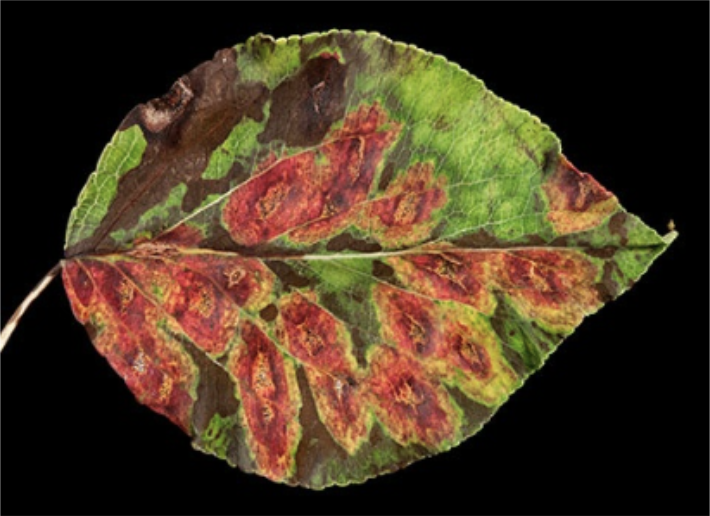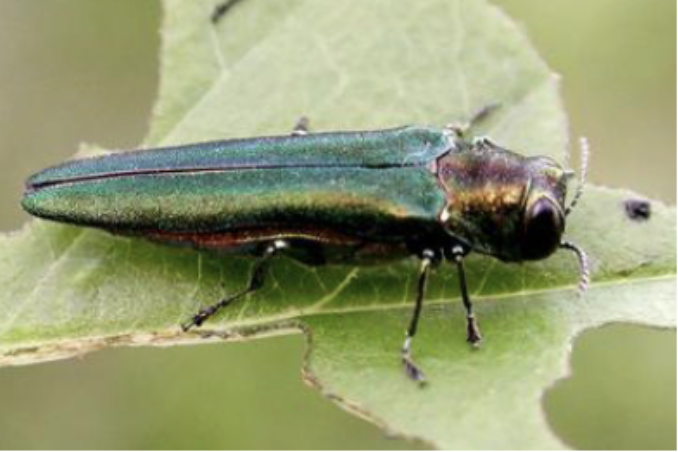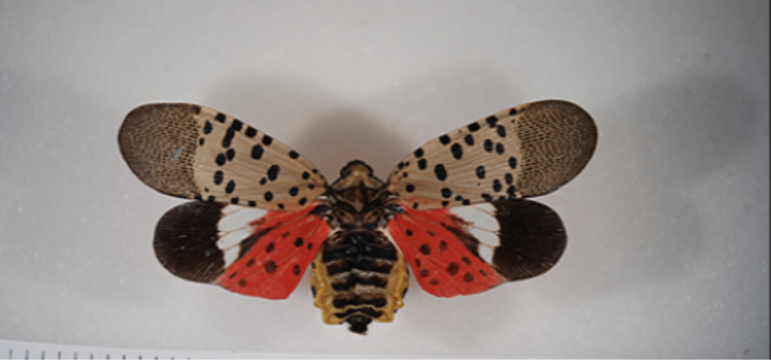
Cornell Extension Photo of a Pear Leaf with Rust.
By James Briand of Trees for Watertown
Watertown’s trees face three distinct invasive pest challenges this year. One, Pear Trellis Rust, is a fungus that has been significantly disfiguring the town’s ornamental pear trees. Another, Emerald Ash Borer, is a small beetle that causes the rapid death of ash trees. The third, Spotted Lantern Fly, is an emerging survival threat to a variety of trees, especially fruit trees.
Watertown Tree Warden Greg Mosman has seen a significant increase in calls from Watertown
residents in recent months regarding Pear Trellis Rust. Pear trees, Mossman observed, are prized by many local residents for their spectacular spring flowers.
Pear Trellis Rust requires two different hosts to complete its annual life cycle: juniper trees or shrubs are its winter host, and pear is the most common summer host. Wind-blown spores can spread the fungus rapidly between neighboring trees. Tell-tale signs of the fungus on pears include yellow to orange spots on leaves and indented areas (cankers) on infected branches.
Unfortunately, treatment options for Pear Trellis Rust are limited. To minimize infection and spread, the more distance between your pear tree and the nearest juniper, the better — minimum of 100 feet is advised. If you have an infected pear tree, be sure to dispose of its fallen leaves and prune off and dispose of twigs or branches that have cankers.

The Emerald Ash Borer is a tiny brilliant-green beetle native to Asia that first appeared in this country in the late 1990s and has now spread to 35 states. Tree damage occurs when the larvae of the EAB beetle burrow and feed on the inner bark and vascular tissue of the host tree. Adult beetles then emerge in the spring, leaving distinctive D-shaped holes in the tree.
The impact of EAB on our native ash tree population is severe. Lacking any natural resistance to this invasive species, 99% of affected ash trees will succumb within 2 to 6 years.
United States Department of Agriculture
Emerald Ash Borer Beetle. 
The Emerald Ash Borer is now present in eleven Massachusetts counties, including Middlesex. While not great in number in Watertown, according to Tree Warden Mosman, the threat of EAB is nonetheless significant as ash trees are some of the town’s most beautiful, mature trees which provide a colorful display in the fall.
Biologic solutions offer the best hope for fighting EAB. Working with the US Department of Agriculture, the Massachusetts Department of Conservation and Recreation (DCR) has introduced 3 species of stingless wasps that attack the larvae and eggs of EAB. Still in early stages, the program shows promise.
The Spotted Lantern Fly is a new threat to Massachusetts trees. Native to Southeast Asia, this pest is undeniably beautiful with pinkish-grey, black-polka-dotted wings and a scarlet undercoat. The fly has had devastating impact in the Mid-Atlantic states and has now reached Massachusetts with presence in nine counties including Middlesex and Suffolk.
United States Department of Agriculture
Spotted Lantern Fly.
The Spotted Lantern Fly feeds on the sap of host trees, especially apple and plum trees, stressing the plants and potentially leading to decreased health and possibly death. Beyond the threat to the trees, the fly is a major nuisance for homeowners; as an SLF feeds, it excretes a sugary substance that builds up and promotes the growth of black, sooty mold that can cover plants, patio furniture, and cars.
While yet to arrive in Massachusetts in great numbers, federal agriculture officials in a recent New York Times article advised “If you see one, be ruthless. Squash and destroy its babies. They are easy to kill.”
For those seeking a less brutal solution, consider removing the Spotted Lantern Fly’s favorite food, the Tree of Heaven, from your yard. Once prized as an urban shade tree, the Tree of Heaven is now seen as an aggressive invasive species that crowds out native trees—and attracts unwanted guests.
The battle against invasive pests is an unending one, but as Tree Warden Mosman observes, “We can maintain the upper hand by being smart about what we plant so as to maintain species diversity and by being vigilant about threats when they arise.”
The situation is far from hopeless! Jiri Hulcr, an entomology professor at the University of Florida, tells about it in this video https://www.youtube.com/watch?v=vYPRZfBJTM4 (I played a small role in a book Jiri has written about bark beetles.)
Beautiful bugs….but I’ll have no problem squishing them now.
I worked with Greg at the City of Boston for 18 years . Watertown landed a good tree guy when they got Greg Mosman.